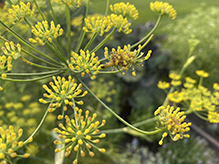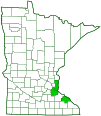Carrot seed moth
(Sitochroa palealis)
Conservation • Description • Habitat • Ecology • Distribution • Taxonomy
| Hodges # | 4986.1 |
||
Conservation Status |
|||
| IUCN Red List | not listed |
||
| NatureServe | NNA - Not applicable SNA - Not applicable |
||
| Minnesota | not listed |
||
Description |
Carrot seed moth is medium-sized snout moth. It is native to Europe, Asia, and North Africa. The first sighting in North America was in Illinois ion 2002. It has rapidly spread since its introduction. In 2008 in was collected in Illinois, Indiana, Michigan, and Wisconsin. It is now well established in North America from Maine to North Carolina west to North Dakota and Missouri, and in Quebec and Ontario Canada. It is still uncommon in Minnesota. Adults are found from June to July in grasslands, gardens, and anywhere else its host species are found. The larva feeds on seed heads of umbellifers, especially Queen Anne’s lace, but also fennel, American cow parsnip, and wild parsnip. It spins a web pulling together flowers within an umbellet. It feeds within the web and later hibernates within it. Adults are have a slender body, are 7⁄16″ to ½″ (11 to 13 mm) long, and have a wingspan of 1″ to 1⅜″ (26 to 34 mm). The abdomen is longer than the hindwings, but this is not visible at rest, when both are covered by the forewings. The wings are broad and are held folded flat when at rest. They are usually silky white, sometimes pale yellow or straw-colored, rarely yellow. Regardless of the base color they usually have a faint greenish tint. On the forewing the veins are slightly darkened in the submarginal area and there is usually a patch of dark scales in the median area at the end of the forewing cell. |
Size |
Total length: 7⁄16″ to ½″ (11 to 13 mm) Wingspan: 1″ to 1⅜″ (26 to 34 mm) |
Similar Species |
Habitat |
Grasslands |
Ecology |
Season |
One generation per year: June and July |
Behavior |
The larva spins a web pulling together flowers within an umbellet. It feeds within the web and later hibernates within it. Adults fly at dusk and at will come to light at night. |
Life Cycle |
|
Larva Hosts |
Seed heads of umbellifers, especially Queen Anne’s lace, but also fennel, American cow parsnip, and wild parsnip. |
Adult Food |
|
Distribution |
||
|
Sources |
|
| 9/12/2025 | ||
Occurrence |
||
|
||
Taxonomy |
|
Order |
|
Superfamily |
Pyraloidea (Pyralid and Crambid Snout Moths) |
Family |
Crambidae (Crambid Snout Moths) |
Subfamily |
Pyraustinae |
Tribe |
Pyraustini |
Genus |
Sitochroa |
Subordinate Taxa |
|
|
|
Synonyms |
|
Phlyctenodes palealis Pyralis palealis Sitochroa algiralis Sitochroa anaxisalis Sitochroa extremalis Sitochroa flaveolata Sitochroa selenalis Spilodes palealis |
|
Common Names |
|
carrot seed moth greenish-yellow sitochroa moth |
|
Glossary
Umbellet
A secondary umbel in a compound umbel.
Visitor Photos
Share your photo of this insect.
This button not working for you?
Simply email us at info@MinnesotaSeasons.com.
Attach one or more photos and, if you like, a caption.
LMG |
 |
In my fennel flowers! They seem to create little hide-a-ways to either molt or hide from predators. Possibly both. In my research, they were discovered along the Great Lakes shipping lanes. It’s non native and was first recorded in Wisconsin on Queen Annes Lace (wild carrot-invasive). Some think it may help curb the spread by keeping the seed heads from dispersing! Can’t decide if I want to keep or rid myself if them. I don't use the fennel for anything but the bulbs and occasion munching of the fronds (myself and Black Swallowtail caterpillars) BUT I don't want them messing with my dill seeds in the future! |
MinnesotaSeasons.com Photos
|

Slideshows

Visitor Videos
Share your video of this insect.
This button not working for you?
Simply email us at info@MinnesotaSeasons.com.
Attach a video, a YouTube link, or a cloud storage link.
LMG
carrot seed moth 01
Aug 25, 2020
Other Videos
[見島のいきものたち 195] ウラグロシロノメイガ Sitochroa palealis
kiokuima

Visitor Sightings
Report a sighting of this insect.
This button not working for you?
Simply email us at info@MinnesotaSeasons.com.
Be sure to include a location.
LMG
8/9/2020
Location: Scott County
In my fennel flowers! They seem to create little hide-a-ways to either molt or hide from predators. Possibly both.
In my research, they were discovered along the Great Lakes shipping lanes. It’s non native and was first recorded in Wisconsin on Queen Annes Lace (wild carrot-invasive). Some think it may help curb the spread by keeping the seed heads from dispersing! Can’t decide if I want to keep or rid myself if them. I don't use the fennel for anything but the bulbs and occasion munching of the fronds(myself and Black Swallowtail caterpillars) BUT I don't want them messing with my dill seeds in the future!
Minnesota Seasons Sightings


